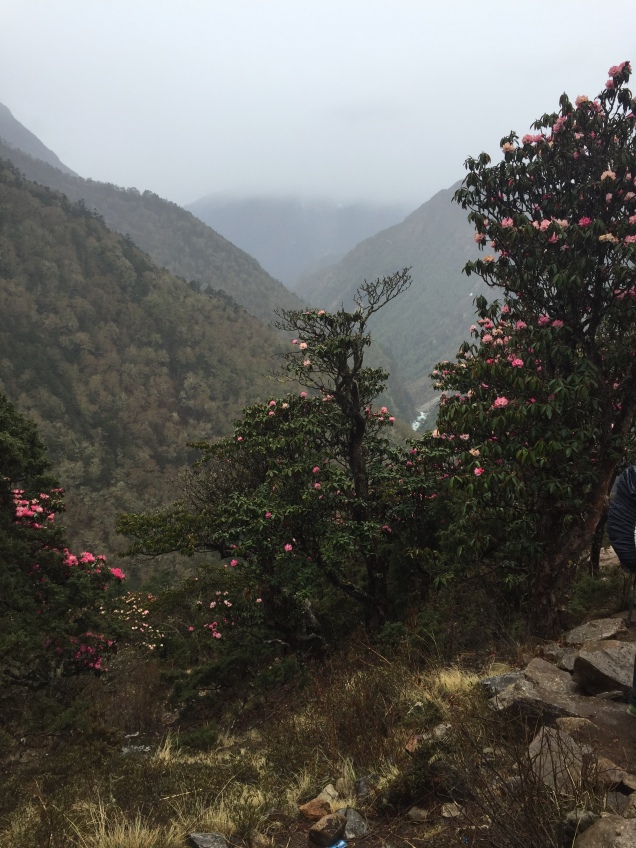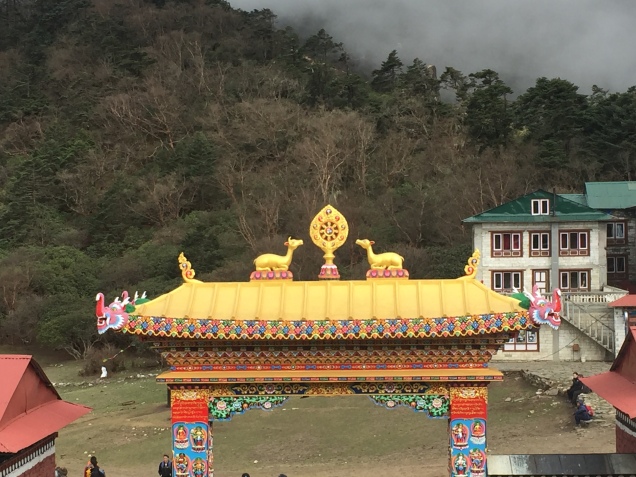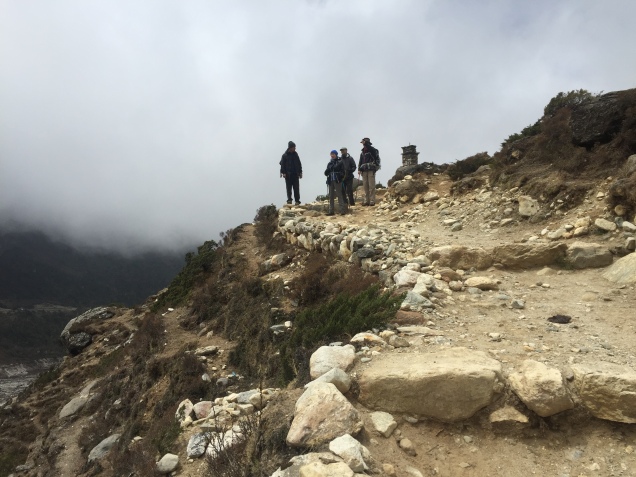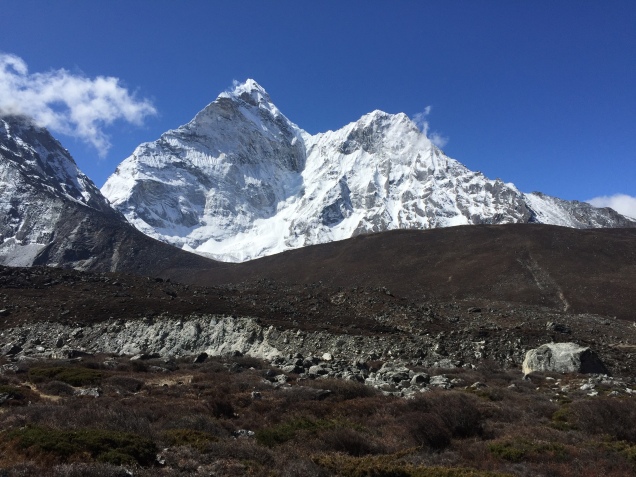
After two nights acclimatizing in Namche Bazaar, it was time for the march to continue. Sleep patterns were by now most peculiar – I found myself asleep by 9 pm, awakening at 1 am or so and reading, and then returning to sleep. I seemed to have reverted to the Middle Ages concept of first and second sleep.
The day we left Namche was the day before Buddha’s Day. We walked clockwise (of course) around the monastery where prayers had already started and along the trail that we had looked down upon the day before. At first it was relatively flat, with some gradual ups and downs. After some time, we entered the Sagamurtha National Park and the altitude where the rhododendrons were still in bloom. Pink, white, red – forming an arcade over the trail. Another swinging bridge – I can feel myself start to sweat – and then time for lunch in a small cafe. The walls were covered in tapestry and all the food was prepared by two women over a wood burning stove. It felt as though we were in an old fashioned gypsy caravan. After, we were backed against a wall by one of the many yak trains coming through. This was S’s first of many encounters of the not good sort with a yak.

A couple of hours of up through layered jagged mountains, overhanging fog, framed by rhododendrons. These mountains are new, geologically speaking, and a young world appeared around each bend in the trail. Light green trees interspersed with dark pines, creating a textures that clothed the mountains. We made it to the top in a respectable time, turned a corner, and suddenly we were at the Tengboche Monastery.
Checked in to the Tashi Delek Lodge and then visited the monastery. Tengboche is centered around the very old monastery – there were a few tea houses for trekkers and a bakery, but we were now far away from the village culture we had previously experienced. It is bucolic. There’s an open meadow area where cows roam, the gate to the monastery and some low buildings where the monks live in numbered rooms, and a few grey stone tea houses.

Six of the 12 resident monks sat in the center, chanting in a low drone. They spend their lives here, in very small rooms. When we stayed at Tengboche on the return, we saw the younger ones going off to play soccer, crimson robes flapping in the wind.
The fog rolled in, slowly covering the small dwellings.
The next day we trekked to Dingboche, where we were to spend two more days acclimatizing to to over 14,000 feet. We could hear prayers chanted in each of the villages as we walked through. The wooded part of the trail soon opened up into a stony valley – the milky river below and some serious rock slides where I did not want to linger. Ultimately we ended up in Upper Pangboche. Most trekkers go through Lower Pangboche only, but it was clear that our guide wanted to make a special stop at the monastery for Buddha’s Day. This is a 400 year old structure, founded by a monk who allegedly flew there. Various people were coming in and out to pray for Buddha’s Day. Z lit a butter lamp, incense was burned, and he prostrated himself three times. A lay monk poured water in all of our cupped hands to drink and smoothe on our foreheads as an act of purification. He also showed us a niche in the wall of the monastery that housed a relic of the flying monk – a bone of some sort.

Hiked on and on, including a stop for lunch, and then another couple of hours to Dingboche. Trail normally about 2 feet wide, sometimes with very steep drops on each side. Across the river the stones were white with splashes of red. We were above the tree line now. Small junipers, yaks, and a lot of helicopters making their way to base camp.
in Dingboche we stayed at the Good Luck lodge. It was packed. We had a nice little room where the sun shone through the window and it was almost warm. The last few have been cold and damp. We are now at the point where yak dung provided the only fuel for the fire in the comunal dining area (which is never ignited before 5 pm). The middle of Dingboche is all privately owned potato fields – to get anywhere you have to walk three sides of a square.
The next day we did an acclimatization hike to the Chukung Valley. We followed the milky river. A wide, stony expanse, with Ama Dablam peering at us from the right, Lhotse to our left, and Island Peak in solitary splendor straight ahead. We stopped at a cafe – and who was there but the guy from the plane. This time he explained that his seat hogging actions had been fueled by a few too many pints after he unexpectedly ran into a cousin at the Dubai airport. He and his friends were doing the three pass EBC route.

There was a piercing wind on the way back and we went much faster. Once safely ensconced in Dingboche, J and I explored the village while M Andy S made friends with some fellow trekkers who were happy to share the very exotic salami they had brought from France. A nice change from gu’s! The dining room was packed because the rooms were so cold.
We were now acclimatized to over 14,000 feet. Next up – two nights at over 16,000 feet – EBC itself and Kala Pattar!

Thank you so much for sharing this amazing experience!
Your stories and photos provide such great insight into the atmosphere and mood of the trek 🙂
LikeLike
Thanks! It’s hard to believe it was less than two weeks ago!
LikeLike
Middle Ages sleep?
LikeLike
Yes! Apparently it was common for hundreds of years for people to go to sleep early – and then arise sometime in the wee hours of morning and conduct some sort of activity – as easy as reading (or praying, in those days) or whatever – and then return to sleep again. I find it much more satisfying to explain it that way than to say I have insomnia.
LikeLiked by 1 person
” Early to Bed, Early to rise? Thanks for the clarification.
LikeLike